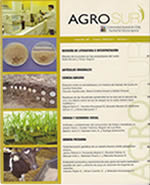Response of naturalized accessions of white clover to low phosphorus condition in Andisols
Main Article Content
Abstract
White clover may generate morpho-physiological adaptations to face soil phosphorus (P) deficiency. Phosphorus use efficiency (PUE) of 9 naturalized white clover accessions (WCAcc) and 2 commercial cultivars Huia and Will (controls) was evaluated under glasshouse conditions. The treatments consisted of increasing levels of P in soil mounted on PVC pots (0.025 m2 x 1 m deep), with 3 replicates and randomly arranged inside a glasshouse. Total dry matter production (DM) and internal P concentration of the above ground materials (PIC) was determined. P uptake and components of PUE were calculated (PAE and PUtE). Additionally, the glasshouse results were compared descriptively with those obtained under field conditions (Acuña and Inostroza, 2013). Six accessions had higher DM production and were more efficient in terms of their general PUE compared to the cv. Huia control, but they did not exceed the cv. Will control. All of the accessions were more efficient in their PUE in the low-middle range of P availability showing no differences compared to the cv. Will control. This behavior was observed under glasshouse and field experimental conditions, both PAE and PUtE of the WCAcc differ in magnitude of the response, which may be associated with interspecific competition and grazing under field conditions. These results indicate that under limited availability of P in the soil the WCAcc collected have a better adaptative response. In addition, the glasshouse results were consistent with the field experiment used in the evaluations.

